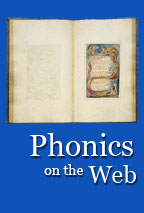A word consists of a series of letters. Every word must have at least one vowel in it. Each syllable is made by blending the sounds of each component, that is, reading the word by adding one sound at a time, as in -e, -ed, bed. The following are some rules for spelling and pronouncing words.
- c followed by e, i or y usually has the soft sound of s. Examples: cyst, central, and city.
- "G" followed by "e, i or y" usually has the soft sound of "j". Example: "gem", "gym", and "gist".
- When two consonants a joined together and form one new sound, they are a consonant digraph. They count as one sound and one letter and are never separated. Examples: "ch,sh,th,ph and wh".
- When a syllable ends in a consonant and has only one vowel, that vowel is short. Examples: "fat, bed, fish, spot, luck".
- When a syllable ends in a silent "e", the silent "e" is a signal that the vowel in front of it is long. Examples: "make, gene, kite, rope, and use".
- When a syllable has two vowels together, the first vowel is usually long and the second is silent. Examples: "pain, eat, boat, res/cue, say, grow". Diphthongs don't follow this rule.
- When a syllable ends in any vowel and is the only vowel, that vowel is usually long. Examples: "pa/per, me, I, o/pen, u/nit, and my".
- When a vowel is followed by an "r" in the same syllable, that vowel is "r-controlled". It is not long nor short. "R-controlled "er,ir,and ur" often sound the same (like "er"). Examples: "term, sir, fir, fur, far, for, su/gar, or/der".
Words may have prefixes or suffixes added to them, which will modify their meaning. For example, the root word use and the suffix -able combine to create the word usable.
Looking for L-Serine powder? Try my other website, Sterling Supplements.




 Forming Words
Forming Words
